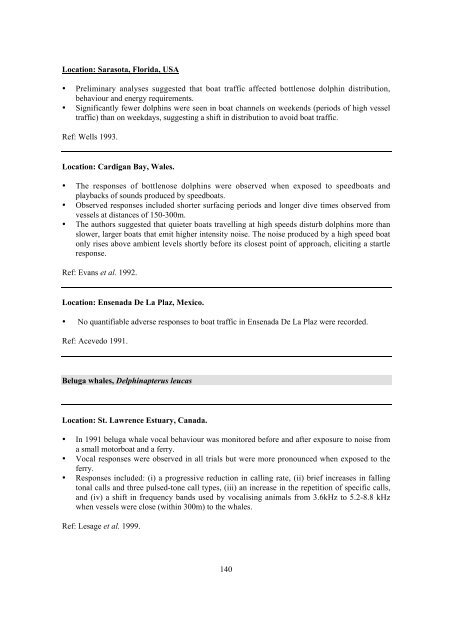Oceans of noise - Whale and Dolphin Conservation Society
Oceans of noise - Whale and Dolphin Conservation Society
Oceans of noise - Whale and Dolphin Conservation Society
- No tags were found...
Create successful ePaper yourself
Turn your PDF publications into a flip-book with our unique Google optimized e-Paper software.
Location: Sarasota, Florida, USA• Preliminary analyses suggested that boat traffic affected bottlenose dolphin distribution,behaviour <strong>and</strong> energy requirements.• Significantly fewer dolphins were seen in boat channels on weekends (periods <strong>of</strong> high vesseltraffic) than on weekdays, suggesting a shift in distribution to avoid boat traffic.Ref: Wells 1993.Location: Cardigan Bay, Wales.• The responses <strong>of</strong> bottlenose dolphins were observed when exposed to speedboats <strong>and</strong>playbacks <strong>of</strong> sounds produced by speedboats.• Observed responses included shorter surfacing periods <strong>and</strong> longer dive times observed fromvessels at distances <strong>of</strong> 150-300m.• The authors suggested that quieter boats travelling at high speeds disturb dolphins more thanslower, larger boats that emit higher intensity <strong>noise</strong>. The <strong>noise</strong> produced by a high speed boatonly rises above ambient levels shortly before its closest point <strong>of</strong> approach, eliciting a startleresponse.Ref: Evans et al. 1992.Location: Ensenada De La Plaz, Mexico.• No quantifiable adverse responses to boat traffic in Ensenada De La Plaz were recorded.Ref: Acevedo 1991.Beluga whales, Delphinapterus leucasLocation: St. Lawrence Estuary, Canada.• In 1991 beluga whale vocal behaviour was monitored before <strong>and</strong> after exposure to <strong>noise</strong> froma small motorboat <strong>and</strong> a ferry.• Vocal responses were observed in all trials but were more pronounced when exposed to theferry.• Responses included: (i) a progressive reduction in calling rate, (ii) brief increases in fallingtonal calls <strong>and</strong> three pulsed-tone call types, (iii) an increase in the repetition <strong>of</strong> specific calls,<strong>and</strong> (iv) a shift in frequency b<strong>and</strong>s used by vocalising animals from 3.6kHz to 5.2-8.8 kHzwhen vessels were close (within 300m) to the whales.Ref: Lesage et al. 1999.140




